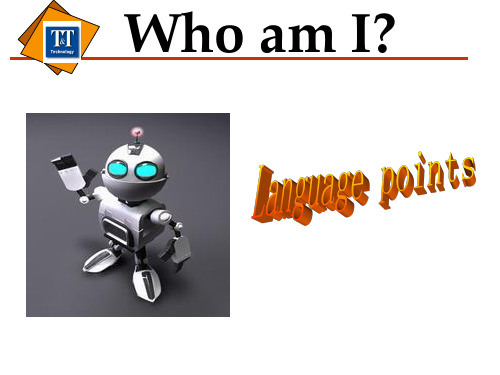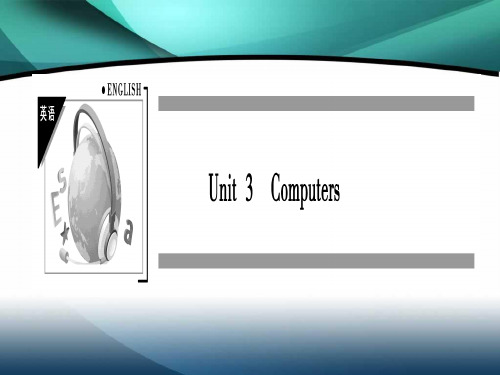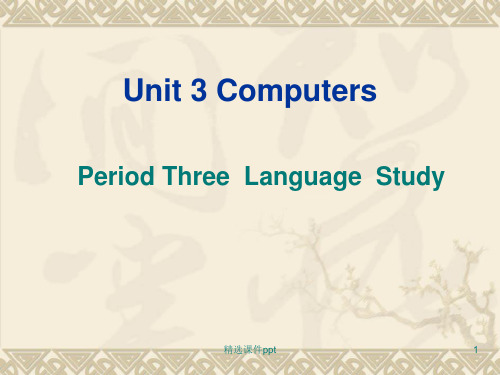高中英语必修二Unit3 Computers Grammar语法课件
合集下载
高中英语人教版必修2课件:Unit 3 Computers

Well, in general, WWW stand for “World Wide Web”. Most people confuse the Internet with the World Wide Web. However, there is a difference. The Internet is made up of thousands of computers that are connected worldwide. WWW or World Wide Web, is what your computer uses to check out the Internet. For example, your computer uses browsers, such as Internet Explorer or Netscape (网景浏览器) to let you see and hear all the cool pictures, information, music and sounds on the Internet.
1.confuse vt. 2.connect vt. 3.browser n. 4.surf vt. 5.modem n. 6.graphics n.
使混乱;使困惑 连接;联合;关联 (电脑)浏览器 在……上冲浪 调制解调器 绘画;图像
1.What difference is there between the Internet and WWW? ________________________________________________________________ 2.What do you need if you surf the World Wide Web? ________________________________________________________________ 【答案】 1.The Internet is made up of thousands of computers that are connected worldwide;WWW is what your computer uses to check out the Internet. 2.You need to have a computer with a modem and a browser.Besides,you need to have an Internet Service Provider.
高中英语:Unit 3 Computers Grammar(新人教必修2).pptx

8. Every possible means
to prevent the air pollution.
A. is used
B. are used
C. has been used
D. have been used
9. No permission
for anyone to enter the building.
C. isn’t being decided
D. aren’t decide
学海无涯
第 3 课时 Grammar 基础练习 1. have been used 2. have been told 3. have been found 4.have been put into
单项选择 1-5 CABDB 6-10 DBCAD 句型转换 1.as well as 2.as, went 3.so that 4.have been written 5.such strong that 单句改错 1.given 后面加to 2.offer 后面加 to 3.just 后面加 been 4.were 改 成 have been 5.去掉 been
B. had ruined D. had been ruined Beijing says that all
construction work for the Beijing
by 2006.
A. has been completed B. has completed
C. will have been completed
3. Great changes
in the city, and a lot of factories
.
A. have been taken place have been set up
人教版高中英语必修二Unit 3 Computers( grammar)(共23张PPT)

Group-work round 2
Computer games have been regarded as a waste of time.
Group-work round 2
It has been wellknown that teachers can help you with your study.
---- Great. Isweanntt etonsceee PpearstotnealrTnasilor.
---- I'm afraid it _h_a_s_n_o_t_b_e_e_n_s_h_o_w_n___(还没上
映) yet.
----SHtohw. ahbaovuet/thhaesFibreesetnordmo?nH_e_a(_sb_iyt_..b_.)e_e_n_s_h_o_w_n (S它th上.映ha了v吗e/)hyaest?not been done
Have fun!
Look around carefully. Close your eyes. Someone will make some changes in the classroom. Check what has been changed.
Group-work
Round 1
Group-work
Lead-in
The similar jacket to Kimi has been sold on the internet.
Present
• The programme has been broadcasted since November.
• The five children have been educated through the game.
人教版高中英语必修二课件Unit3Computers——grammar课件

【学以致用】My brother has
bought thisFbike for almost four years.(改错) HowT long has this book
been bought(判断正误)
(4) 带有双宾的词,如__g_i_v_e,_,s_e_n_d_,b,_ri_n_g_, __ta_k_e_,_te_a_c_h,,_te_l_l_,w__r,i_te_,_b_u_y,p_a_y___等,变为被动语 态时,将其中一个宾语变为主语,其他借助介词 to 或者for。 【学以致用】The teacher has given twins a book. (用被动时态对句子进行改写)
Their photos have been made fun of by the netizens.
现在完成时被动态结构:
have /has +been +过去分词
时间状语 现在完成时常与already ,yet recently ,so far ,by now, up till now ,since .....,before......等连用
had been done
过去将来时
would be done
一般将来时
will be done
现在完成时
have/has been done
歌诀是:被动语态be字变,过去分词跟后面。
ห้องสมุดไป่ตู้
现在完成时态
定义:现在完成时的动作或情况虽然发生在
过去,但它强调的是与现在的关系,用来说 明现在的情况。 现在完成时态结构:(have/has + 过去分词)
思
The programme has been broadcasted since November.
bought thisFbike for almost four years.(改错) HowT long has this book
been bought(判断正误)
(4) 带有双宾的词,如__g_i_v_e,_,s_e_n_d_,b,_ri_n_g_, __ta_k_e_,_te_a_c_h,,_te_l_l_,w__r,i_te_,_b_u_y,p_a_y___等,变为被动语 态时,将其中一个宾语变为主语,其他借助介词 to 或者for。 【学以致用】The teacher has given twins a book. (用被动时态对句子进行改写)
Their photos have been made fun of by the netizens.
现在完成时被动态结构:
have /has +been +过去分词
时间状语 现在完成时常与already ,yet recently ,so far ,by now, up till now ,since .....,before......等连用
had been done
过去将来时
would be done
一般将来时
will be done
现在完成时
have/has been done
歌诀是:被动语态be字变,过去分词跟后面。
ห้องสมุดไป่ตู้
现在完成时态
定义:现在完成时的动作或情况虽然发生在
过去,但它强调的是与现在的关系,用来说 明现在的情况。 现在完成时态结构:(have/has + 过去分词)
思
The programme has been broadcasted since November.
高中英语必修二Unit3-Computers-Grammar语法课件

China since 1978.
17
2) open, break, drop等不强调动作发出者 时常用主动语态。如: [误] The door has been opened of itself. [正] The door has opened of itself. 3. 短语动词不可分割或省略其中的介词
(1) 不知道或没有必要说明动作的执行者 是谁。
如: Some new computers were stolen last
night. 一些新电脑在昨晚被盗了。
(不知道电脑是谁偷的)
This book was published in 1981.
这本书出版于1981年。
21
(2) 强调动作的承受者, 而不强调动作的执 行者。 如: The window was broken by Mike.
28
Look at the way your face has been washed Look at the way your hair has been combed Look at the way your shoes have been cleaned You’d better do them again. Look at the way the flowers have been planted Look at the way the grass has been cut Look at the way the paths have been swept I hope that you’ll come here again.
believed. 16
2. 并不是所有动词都有被动语态
1) happen, take place, break out, belong to, cost, last等不及物动词或词组无被 动语态。如: [误] Great changes have been taken
17
2) open, break, drop等不强调动作发出者 时常用主动语态。如: [误] The door has been opened of itself. [正] The door has opened of itself. 3. 短语动词不可分割或省略其中的介词
(1) 不知道或没有必要说明动作的执行者 是谁。
如: Some new computers were stolen last
night. 一些新电脑在昨晚被盗了。
(不知道电脑是谁偷的)
This book was published in 1981.
这本书出版于1981年。
21
(2) 强调动作的承受者, 而不强调动作的执 行者。 如: The window was broken by Mike.
28
Look at the way your face has been washed Look at the way your hair has been combed Look at the way your shoes have been cleaned You’d better do them again. Look at the way the flowers have been planted Look at the way the grass has been cut Look at the way the paths have been swept I hope that you’ll come here again.
believed. 16
2. 并不是所有动词都有被动语态
1) happen, take place, break out, belong to, cost, last等不及物动词或词组无被 动语态。如: [误] Great changes have been taken
人教版高中英语必修2Unit3computers阅读课Languagepoints知识点课件

句型:so… that… 如此……以致于……
The stone is so heavy that no one can lift it. He worked so hard that he forgot everything.
so+形容词/副词位于句首时,句子用倒装结构。
So hard did he work that he forgot everything.
Language points
Adj. + ly Adv.
n.
v.
total + ly totally logical+ly logically
universal universally
你能把以下adj.变成n.吗?
intelligent intelligence
happy
happiness
operator calculator designer application revolution
1. so + adj. /adv. +that…
2. so + adj. +a + n. that…
3. such + a + adj. + n. that…
Language points
Q 1: 如果n是复数或un,怎么办? 用such ! They are _s_uc_h_ beautiful girls that we all like them. It is _s_u_c_h_ important information that you need to deal with it carefully. Q 2:如果adj.是表示多少的词, 怎么办?用so ! There are _s_o__ many girls in my room that I started to think that I was dreaming. I have __s_o__ much money that I don’t know what to do.
The stone is so heavy that no one can lift it. He worked so hard that he forgot everything.
so+形容词/副词位于句首时,句子用倒装结构。
So hard did he work that he forgot everything.
Language points
Adj. + ly Adv.
n.
v.
total + ly totally logical+ly logically
universal universally
你能把以下adj.变成n.吗?
intelligent intelligence
happy
happiness
operator calculator designer application revolution
1. so + adj. /adv. +that…
2. so + adj. +a + n. that…
3. such + a + adj. + n. that…
Language points
Q 1: 如果n是复数或un,怎么办? 用such ! They are _s_uc_h_ beautiful girls that we all like them. It is _s_u_c_h_ important information that you need to deal with it carefully. Q 2:如果adj.是表示多少的词, 怎么办?用so ! There are _s_o__ many girls in my room that I started to think that I was dreaming. I have __s_o__ much money that I don’t know what to do.
【人教版】必修二 unit 3 computers grammar优质课件

Where has he been sent to study the new technology?
【人教版】必修二 unit 3 computers grammar优质课件
【人教版】必修二 unit 3 computers grammar优质课件
Great changes ______B__ in the city , and a lot of
A pen-like computer has already been developed.
Can you make more sentences similar to the sentences above? “have/has been done ?”
?
【人教版】必修二 unit 3 computers grammar优质课件
【人教版】必修二 unit 3 computers grammar优质课件
【人教版】必修二 unit 3 computers grammar优质课件
1. ------HSoinwcleo1n9g9_0_.B___ at this job?
A. were you employed B. have you been employed
The buildings; destroy ; earthquake
【人教版】必修二 unit 3 computers grammar优质课件
Discovering: Do the underlined parts have
something in common? 1. A calculating machine has been replaced with
• 三、 巩固练习
1.-How many times______ not to play with fire?
【人教版】必修二 unit 3 computers grammar优质课件
【人教版】必修二 unit 3 computers grammar优质课件
Great changes ______B__ in the city , and a lot of
A pen-like computer has already been developed.
Can you make more sentences similar to the sentences above? “have/has been done ?”
?
【人教版】必修二 unit 3 computers grammar优质课件
【人教版】必修二 unit 3 computers grammar优质课件
【人教版】必修二 unit 3 computers grammar优质课件
1. ------HSoinwcleo1n9g9_0_.B___ at this job?
A. were you employed B. have you been employed
The buildings; destroy ; earthquake
【人教版】必修二 unit 3 computers grammar优质课件
Discovering: Do the underlined parts have
something in common? 1. A calculating machine has been replaced with
• 三、 巩固练习
1.-How many times______ not to play with fire?
高中英语 2Unit3Computers课件 新人教必修2

v.计算;打算;推测
即学即用 (1)这些广告旨在吸引年轻的单身消费者。 The advertisements attract young single consumers. (2)据估算,去年至少丧失了47 000个工作。 at least 47,000 jobs were lost last year.
from...on
as a result
so...that
in a way
with the help of
deal with
watch over
in common
make up
after all
Ⅲ.典型句式运用 1.I developed very slowly and it took nearly two hundred years before I was built as an analytical machine by Charles Babbage.我发 育缓慢,差不多到了两百年之后,查尔斯·巴比 奇才把我制成了一台分析机。 (1)“It took/was+一段时间+before 从句”是一个固定句型,意为“ ”。 (2)before用于这类句型时的结构还有: ①It didn’t take/was long (或一段时间) before...过了不久(一段时间)就……
考点提炼
过了……后才……
②It will take/be long (或一段时间) before...要过很久(一段时间)才…… ③It won’t take/be long (或一段时间) before...不久(一段时间后)就会…… 2.As time went by,I was made smaller.随着时间 的推移,我被制造得越来越小。 句中的as是连词,引导 从句, 意为“ ”或“ ”。 表示“随着……”时,也可以用with,但with后只 接名词短语。
即学即用 (1)这些广告旨在吸引年轻的单身消费者。 The advertisements attract young single consumers. (2)据估算,去年至少丧失了47 000个工作。 at least 47,000 jobs were lost last year.
from...on
as a result
so...that
in a way
with the help of
deal with
watch over
in common
make up
after all
Ⅲ.典型句式运用 1.I developed very slowly and it took nearly two hundred years before I was built as an analytical machine by Charles Babbage.我发 育缓慢,差不多到了两百年之后,查尔斯·巴比 奇才把我制成了一台分析机。 (1)“It took/was+一段时间+before 从句”是一个固定句型,意为“ ”。 (2)before用于这类句型时的结构还有: ①It didn’t take/was long (或一段时间) before...过了不久(一段时间)就……
考点提炼
过了……后才……
②It will take/be long (或一段时间) before...要过很久(一段时间)才…… ③It won’t take/be long (或一段时间) before...不久(一段时间后)就会…… 2.As time went by,I was made smaller.随着时间 的推移,我被制造得越来越小。 句中的as是连词,引导 从句, 意为“ ”或“ ”。 表示“随着……”时,也可以用with,但with后只 接名词短语。
高中英语人教版必修2 Unit 3 Computers 课件

What’s next?
carry things work in wars work for us in Mars
Activity 2 Thinking Q: In what ways is the computer used?
communicate with…
Watch movies & TV plays
More knowledge about computers
1. What is IT? Information Technology.
2. What is CPU? Central Processing Unit.(中央处理器) 3. What is WWW? World Wide Web. 4. What is the English for “科学技术”? science and technology.
listen to music
do shopping
search for …
play computer games
Besides, we can … with computers
• send e-mails instead of letters;
• read news at home and abroad;
register 注册,登记 software 软件
download 下载
hardware 硬件
Consolidation
• Complete the sentences with proper words. 1. We should use computers properly and
never be a m_o_u_se__ potato. 2. In the accident he e_s_ca_p_e_d_ being killed. 3. You can input the capital letters when you
人教版选修二Unit 3 ComputersGrammar 课件(共33张PPT)

【注意二】 2. 注意与一般过去时被动语态的区别。
一般过去时仅表示一个过去的动作或事实, 与现在无关;
现在完成时则表示一个过去的动作对现在 的影响,或一直持续到现在,与现在有 关。
The machine has been repaired.
机器已经修好了。(说明动作发生在过去, 对现在有影响,修好了。) The machine was repaired yesterday.
Unit 3 Grammar
The Present Perfect Passive Voice
Look at the following sentences. 1. An opinion is what someone believes is true but has not been proved. 2. So even the olive wreath has been replaced! 3. The fantastic modern buildings have been designed by Kurt Gunter
【注意四】 4. 并不是所有动词都有被动语态
happen, take place, break out, belong to, cost, last等不及物动词或词组无被动语 态。 [误] Great changes have been taken place in China since 1978. [正] Great changes have taken place in China since 1978.
机器昨天修了。(只说明动作发生 在昨天。)
【注意三】 3. 副词的位置 often, usually, always, never, hardly, seldom等副词置于have / has和been中间。 如: [误] Such a man has been hardly believed. [正] Such a man has hardly been believed.
高中英语人教版必修二《Unit3 Computers》课件

Fill in the blanks
I am a(n) ___st_r_ik_e_rin an android football team.
Self
I look like a human and I’m as big as a
introductio human.
n
My computer ___c_h_ip_s_ help me move and
= ___W_h_i_le__d_o_i_n_g_h_i_s_E_n_g_li_s_h________ ___h_o_m_e_w__o_r_k_, _h_e_f_e_ll_a_s_le_e_p__. _____
5. Then she prepares reliable moves to use if a new situation arises. arise vt. 产生,产生; 站起来,起身;起床;上升, 升起
拓展
in the way或in one’s way 挡道,碍事 反义词组:out of the way in any way 不管如何,不管怎样 in no way 决不 注意:置于句首时,句子用部分倒装语序。如:
You’ll have to move — you are in my way. Please keep out of the way. I must finish the work today in any way. Teaching in school can in no way be separated from practice. In no way did he admit that he was wrong.
4) A heavy smoke arose and hung over the town.
人教版高一必修二book2-unit3-Computers--grammar-课件

2. …, I have been used in offices and homes since the 1970s.
3. … I never forget anything I have been told!
4. Since the 1970s, many new applications have found for me.
人教版高一必修二book2-
unit3-Computers-grammar-课件
Task1. Presentation
I. Read the sentences from the text, paying attention to the underlined parts. 1.Over time I have been changed quite a lot.
3.这座城市明年将建多少座大楼? How many high buildings ________________in this city next year? 答案:will be built 4.为了多种一些谷物,很多树被砍掉了。 Large numbers of trees ______________to grow more grain. 答案:have been cut down
The work has already been finished. 工作已完成了。(结果是,现在不用做这项工作了)
2) 表示一个被动的动作或状态开始于过去,持续 到现在,并有可能持续下去,常与for或since引导 的时间状语连用,或用于How long...?句型中。例 如:
The plan has been discussed for nearly 2 hours. 这项计划已被讨论了近两个小时了。 3) 用在时间或条件状语从句中,表示将来某时已 完成的动作,即用现在完成时的被动语态代替将 来完成时的被动语态。
3. … I never forget anything I have been told!
4. Since the 1970s, many new applications have found for me.
人教版高一必修二book2-
unit3-Computers-grammar-课件
Task1. Presentation
I. Read the sentences from the text, paying attention to the underlined parts. 1.Over time I have been changed quite a lot.
3.这座城市明年将建多少座大楼? How many high buildings ________________in this city next year? 答案:will be built 4.为了多种一些谷物,很多树被砍掉了。 Large numbers of trees ______________to grow more grain. 答案:have been cut down
The work has already been finished. 工作已完成了。(结果是,现在不用做这项工作了)
2) 表示一个被动的动作或状态开始于过去,持续 到现在,并有可能持续下去,常与for或since引导 的时间状语连用,或用于How long...?句型中。例 如:
The plan has been discussed for nearly 2 hours. 这项计划已被讨论了近两个小时了。 3) 用在时间或条件状语从句中,表示将来某时已 完成的动作,即用现在完成时的被动语态代替将 来完成时的被动语态。
人教版必修二 book2unit3 grammar 语法课课件 36张

这些汽车修好了吗? 不,还没有。
4. How long has her work been finished ?
她的工作完成有多久了?
-9-
The Present Perfect Passive Voice
(现在完成时的被动语态)
讲解归纳 1. 构成:
现在完成时
主动语态 have/has done
-13-
2) 表示一个被动的动作或状态开始于过去,持续 到现在,并有可能持续下去,常与 for 或since引导 的时间状语连用,或用于 How long... ?句型中。例 如: The plan has been discussed for nearly 2 hours. 这项计划已被讨论了近两个小时了。 3) 用在时间或条件状语从句中,表示将来某时已 完成的动作,即用现在完成时的被动语态代替将 来完成时的被动语态。 You can go home as soon as your task has been finished. 你的任务一完成就可以回家。
被动语态 have/hasbeendone
-10-
2. 现在完成时被动语态的各种句式: [肯定式] have/has +been +done
Your computer has been repaired. 你的电脑已经修好了。
[否定式] have/has +not +been +done
The desks have not been cleaned. 这些桌子还没有擦干净。
-16-
5.我喜欢这部科幻电影,它已经在电视上播了三 次了。 I like this science fiction film and it _____________ three timeast
4. How long has her work been finished ?
她的工作完成有多久了?
-9-
The Present Perfect Passive Voice
(现在完成时的被动语态)
讲解归纳 1. 构成:
现在完成时
主动语态 have/has done
-13-
2) 表示一个被动的动作或状态开始于过去,持续 到现在,并有可能持续下去,常与 for 或since引导 的时间状语连用,或用于 How long... ?句型中。例 如: The plan has been discussed for nearly 2 hours. 这项计划已被讨论了近两个小时了。 3) 用在时间或条件状语从句中,表示将来某时已 完成的动作,即用现在完成时的被动语态代替将 来完成时的被动语态。 You can go home as soon as your task has been finished. 你的任务一完成就可以回家。
被动语态 have/hasbeendone
-10-
2. 现在完成时被动语态的各种句式: [肯定式] have/has +been +done
Your computer has been repaired. 你的电脑已经修好了。
[否定式] have/has +not +been +done
The desks have not been cleaned. 这些桌子还没有擦干净。
-16-
5.我喜欢这部科幻电影,它已经在电视上播了三 次了。 I like this science fiction film and it _____________ three timeast
英语必修二人教版 Unit3 Computers2.3+grammar (共23张PPT)

●主语是行为动作的承受者
●谓语动词表示动作已经完成 例如: I have been told about it many times. The bridge has just been built.
Change the following sentences into the
present perfect passive voice.(见课本P21)
课文内容复习:用动词正确形式填空.
1. First as a PC and then as a laptop, I h_a_v_e__b_ee_n__u_s(eudse) in offices and homes since the 1970s.
2. Over time my memory _h_a_s_d_e_v_e_lo_p_e(ddevelop) so much that, like an elephant, I never forget anything I h_a_v_e_b_e_e_n__to_l(dtold).
1.A new personal computer has been bought by my friend.
2.My computer has been repaired by the shop very quickly.
3.My computer has just been attacked by an unknown virus.
Exercises
1. Both my brother work at the power
station that ___ in my hometown.
A. has set up
B. has been set up
C. was set up
●谓语动词表示动作已经完成 例如: I have been told about it many times. The bridge has just been built.
Change the following sentences into the
present perfect passive voice.(见课本P21)
课文内容复习:用动词正确形式填空.
1. First as a PC and then as a laptop, I h_a_v_e__b_ee_n__u_s(eudse) in offices and homes since the 1970s.
2. Over time my memory _h_a_s_d_e_v_e_lo_p_e(ddevelop) so much that, like an elephant, I never forget anything I h_a_v_e_b_e_e_n__to_l(dtold).
1.A new personal computer has been bought by my friend.
2.My computer has been repaired by the shop very quickly.
3.My computer has just been attacked by an unknown virus.
Exercises
1. Both my brother work at the power
station that ___ in my hometown.
A. has set up
B. has been set up
C. was set up
人教版高一英语必修二课件:Unit3Computers (共77张PPT)

6._c_a_lc_u_l_a_te_ vt. 计算 _c_a_lc_u_l_a_ti_o_n_ n. 计算;估计;推测 _c_a_l_c_u_la_t_o_r_ n. 计算器 7.__s_i_m_p_l_if_y_ vt. 简化 _s_i_m_p__le_ adj. 单纯的;易懂的;朴素的 _s_i_m_p__ly_ adv. 简单地;朴素地;仅仅
appearance 11._a_p_p_e_a_r_____ n. 外观;外貌;出现
te_c_h_n_o_l_o_g_y_ vi. 出现 12.te_c_h_n_o_l_o_g_ic_a_ln. 工艺;科技;技术
c_h_a_r_a_c_te_r_____ adj. 科技的 13.c_h_a_r_a_ct_e_r_is_t_icn. 特点;性格
logical 19.lo_g_i_c_a_ll_y__ adj. 合逻辑的;合情理的
u_n_iv_e_r_s_a_l_ adv. 逻辑上;合逻辑地 u2n0i.ve_r_s_e_____ adj. 普遍的;通用的;宇宙的 ____a_r_t_i_fi_cianl. 宇宙 21.a_n_y_h_o_w____ adj. 人造的;假的 22.________ adv. 无论如何;即使如此
5.He has thought of a way of solving the problem.
→_________________________________________ ______A__w_a.y of solving the problem has been thought of
2.signal vi & vt.发信号 n.信号 [教材原句] For example,I have learned to signal to my teammates in computer language to give me the ball when I am open and have a good shot for a goal. 例如,当我启动的时候,我可以用计算机语言向队友 示意把球传给我,这样可以有一个漂亮的射门。
新人教版高中英语必修二《Unit 3 Computers》精品

11. intelligent 12. solve 13.reality 14.personal 15.Personally 16.total 17. totally 18.application 19. explore 20. anyhow 21.goal 22.happiness 23.arise 24.appearance 25.character
been __to_t_a_ll_y__ (完全地) changed. People have
to __e_xp_l_o_re__(探索) solutions by surfing the
Internet. __A_n_y_h_o_w_(不管怎样), computers have
changed people’s way of life!
Computers can simplify your work, by calculating difficult sums easily.
精选课件ppt
8
personal
就我个人看Leabharlann 来,学生应 当恰当地使 用电脑。Personally, students should Use computers in a proper way.
精选课件ppt
12
Witing Task
❖ 写短文描述下面的现象并谈谈你的个人看法。
❖ 当今时代,电脑普遍应用,它不仅通过轻松计算 任何难题的方式简化我们的工作,而且还能帮助 我们解决任务,而这些任务往往是在短时间内难 以完成的。因而不少学生对电脑如此着迷以至于 花费了大量的时间,结果他们考试不及格。即使 如此,个别学生还是疯狂地探究它。
1)so +adj/adv +that从句。 2) so +adj+ a(n)+单数可数名词+that从句。 3)so+ many/much/few/little +名词+that从句。 Such…that表示“如此…以至于”引导结果状语
高中英语unit 3 computers课件新人教版必修2

A. Since the 1970s people have discovered new use for me.
B. Since the 1970s people have found me many new rules.
Listening
I have been changed quite a lot over time. I began as a calculating machine in 1642 in France. In 1822 I was built _______ ________ analytical ______. machine Then in 1936 Alan Turing wrote a as an _______ universal ______. machine As time went by, I was book and built a _______ made smaller. Since the 1970s, I have been used in offices laptop and homes, first as a ___ PC and then as a _______. These changes only became possible as my memory tubes then on transistors improved. First it was stored in ____, _______ chips In the 1960s they gave me and later on very small ____. network Now people call it the a family connected by a _______. World _____ Wide Web _____ ____ or the Internet. Many new applications have also been found for me. I have been widely applied in communication ___________, finance, trade ____, mobile phones operations and _____ space robots, _____ _____, medical ________ rockets happiness that I am a ______. I am now filled with ________ friend and helper of humans.
- 1、下载文档前请自行甄别文档内容的完整性,平台不提供额外的编辑、内容补充、找答案等附加服务。
- 2、"仅部分预览"的文档,不可在线预览部分如存在完整性等问题,可反馈申请退款(可完整预览的文档不适用该条件!)。
- 3、如文档侵犯您的权益,请联系客服反馈,我们会尽快为您处理(人工客服工作时间:9:00-18:30)。
(3) 把主动语态中的主语放在介词by之后作 宾语, 将主格改为宾格。例如: All the people laughed at him. He was laughed at by all people. They make the bikes in the factory.
The bikes are made by them in the
You’d better do them again.
Look at the way the flowers have been planted
Look at the way the grass has been cut
Look at the way the paths have been swept I hope that you’ll come here again.
7) 动词不定式的被动式 (to be + 过去分词) 如: It is an honor for me to be asked to speak here.
现在完成时的被动语态
现在完成时的被动语态表示动作发生在
过去, 到现在已经完成或对现在仍有影响,
其构成是: have/has been + done。例如:
seldom等副词置于have/has和been中间。 如: [误] Such a man has been hardly believed. [正] Such a man has hardly been believed.
2. 并不是所有动词都有被动语态 1) happen, take place, break out, belong to, cost, last等不及物动词或词组无被 动语态。如: [误] Great changes have been taken place in China since 1978. [正] Great changes have taken place in China since 1978.
3) 一般将来时的被动语态 (will/shall + be + 过去分词或 + be going to + be + 过去分词) 如: The work will be finished soon. 4) 现在进行时的被动语态 (is/am/are + being + 过去分词) 如: The bridge is now being constructed.
(我或别人现在进不去) 门已经被锁上了。
有人告诉他这事很多次了。
(可能还会有人告诉他)
4. 用在时间和条件状语从句中, 表示将来某时已完成的动作。如:
We’ll start as soon as the work has
been finished.
工作一完成我们就立即动身。
1. 副词的位置
often, usually, always, never, hardly,
它们的构成的区别在最后的动词上, 被动态接的是过去分词形式, 现在完成 进行时接的是现在分词形式。 1. 主语是行为动作的承受者。如: The Temple of Zhang Fei has been rebuilt. 张飞庙已经过重建。
2. 说话时已经完成的动作或出现的结果。 如: The door has been locked. 3. 动作或状态始于过去, 持续到现在, 并可 能持续下去。如: He has been told about it for many times.
days 等。
不能用在现在完成进行时态的动词, 如:be, have, like, love, know, believe,
hate等。
一般过去时则是表示过去某时发
生的动作或情况, 与现在毫无关系。
2) 现在完成进行时 (have/has + been + 现 在分词)
2. 七种被动语态形式
1) 一般现在时的被动语态 (am/is/are + 过 去分词) 如: The work is done during two days. 2) 一般过去时的被动语态 (was/were + 过 去分词) 如: He was sent to the hospital immediately after the accident.
Things that have been done well the way the flowers have been planted the way the grass has been cut
Things that have been done badly the way your face has been washed the way your hair has been combed the way your shoes have been cleaned
already, always, often, ever, never, yet,
not...yet, just等不表示明确的时间副词
连用, 还可以和表示时间一直延续到目
前的带since, for 的状语及包括现在在
内的词连用。如: now, today, this
month, this year, recently, these few
从A、B、C、D四个选项中,选 出可以填入空白处的最佳选项。 1. In the last few years thousands of films _____ all over the world. (天津2011) A. have produced B. have been produced C. are producing D. are being produced
5) 现在完成时的被动语态 (have/has +been
+ 过去分词) 如: The radio has been repaired when we phoned the shop. 6) 带情态动词的被动语态 (情态动词 + be + 过去分词) 如: This can be done in a few minutes.
人教课标 高一 必修 2 Unit 3
The Present Perfect Passive Voice
现在完成时的被动语态
1. 两种时态
1) 现在完成时(have/has + 过去分词)
现在完成时的动作或情况虽然发生在过
去,但它强调的是与现在的关系,用来 说明现在的情况。现在完成时不能与表 示确定的过去时间的状语连用, 如: yesterday, two weeks ago, in 1978, when I got there 等, 现在完成时常与
your bed has been made Look at the way ________________________ your carpet has been swept Look at the way ________________________ Look at the way your shoes have been tidied ________________________ _________________________________ I hope that you’ll come here again.
行者。
如: The window was broken by Mike.
窗户是迈克打破的。 This book was written by him. 这本书是他写的。
主动语态变被动语态的方法
(1) 把主动语态的宾语变为被动语态的主 语。 (2) 把谓语变成被动结构(be+过去分词) (根据被动语态句子里的主语的人称和 数,以及原来主动语态句子中动词的 时态来决定be的形式)。
following poem. Then fill in the chart below.
Look at the way your face has been washed Look at the way your hair has been combed Look at the way your shoes have been cleaned
5) 带复合宾语的动词变被动语态时, 只能 将宾语变为主语, 原来的宾补保留不 动, 改称主语补足语。 主动:I have asked her to help you. 被动:She has been asked to help you.
Underline the use of the
present perfect voice in the
1. The dirty clothes have been washed. 脏衣服都已经洗了。 2. The plan has been studied by the
experts for three times.
这项计划已经由专家研究过三次了。
3. The child has been taken care of by Grandma Wang all these years. 这些年来, 这个小孩一直由王奶奶照料。 现在完成时被动态: have / has + been + 动词过去分词 现在完成进行时: have / has + been + 动词现在分词
the way the paths have been swept
Read this poem aloud, paying attention to
the rhythm and intonation. Then write your own poem. Look at the way the table has been laid ______________________ Look at the way the glasses have been placed ______________________ Look at the way the food has been cooked ______________________ _________________________ You’d better do them again.
